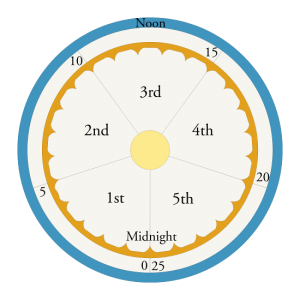Difference between revisions of "Quintary"
Jump to navigation
Jump to search
Trismegistus (talk | contribs) m |
Trismegistus (talk | contribs) m |
||
| Line 1: | Line 1: | ||
[[File:Quintary.png|thumb|300px|Example showing the face of the 25-hour clock common on Asdar]] | [[File:Quintary.png|thumb|300px|Example showing the face of the 25-hour clock common on Asdar]] | ||
| − | An international term for the commonly used twenty-five hour clock, divided into five 'quintaries' of five hours each. A twenty-five hour period according to modern-day Pallathantic reckoning begins at midnight. | + | An international term for the commonly used twenty-five hour clock, divided into five 'quintaries' of five hours each. A twenty-five hour period according to modern-day Pallathantic reckoning begins at midnight. The Nour Hour is the middle hour of the day. Since it has an odd number of hours, there is no exactly middle division in an Asdaran Day to Night cycle. |
The value of five and five squared is also associated with the duration of the common month which typically has twenty five days. It is also associated with the power of Chaos in some contexts. | The value of five and five squared is also associated with the duration of the common month which typically has twenty five days. It is also associated with the power of Chaos in some contexts. | ||
Revision as of 12:02, 12 January 2017
An international term for the commonly used twenty-five hour clock, divided into five 'quintaries' of five hours each. A twenty-five hour period according to modern-day Pallathantic reckoning begins at midnight. The Nour Hour is the middle hour of the day. Since it has an odd number of hours, there is no exactly middle division in an Asdaran Day to Night cycle.
The value of five and five squared is also associated with the duration of the common month which typically has twenty five days. It is also associated with the power of Chaos in some contexts.
See Also
| This article is a stub. It requires further development by the creator. |
